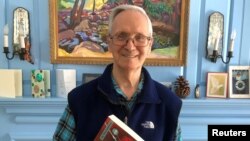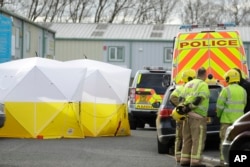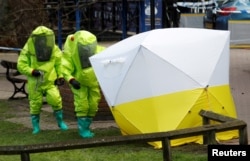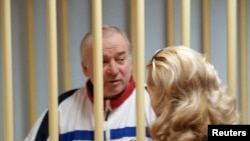Vil Mirzayanov is a Russian emigre to the U.S. and chemical weapons specialist who helped develop the poison believed to have been used in the attack in Britain on Sergei Skripal, a former colonel in the GRU, Russia’s military intelligence, and his daughter Yulia.
Mirzayanov spoke with VOA’s Russian service.
Q: You were involved in the development of unique Soviet chemical toxic substances of nerve agent, “Substance 33,” “A-232” and “А-234,” known today as “Novichok” (Newcomer). At the same time, you claim that no other country in the world except Russia has ever had such weapons. How were British investigators able to establish what kind of substance was used to poison Sergei Skripal?
Mirzayanov: To establish which chemical agent was used in this case, you need to have access to a powerful high-resolution mass spectrometer, in the library of which are the spectra of all known compounds. The sample taken is compared with those already known, and the computer indicates a spectrum with a 96 percent probability. That is, there can be no error here.
Q: But to do this, investigators must have a sample?
Mirzayanov: That is the usual procedure. You can take blood, urine, extract a sample from the clothes by using solvents. There are a variety of ways.
Q: Russian officials have repeatedly stated that the chemical used for poisoning ex-GRU Colonel Sergei Skripal could have been produced in other countries, including Britain. You say that in England there were models of Novichok.
Mirzayanov: The British could easily have synthesized it on the basis of the formulas that I published in my book, published in 2008 (State Secrets: An Insider’s Chronicle of the Russian Chemical Weapons Program Secrets). Each country takes care of its own security, and as part of the study of possible threats, a model could have been created.
So the test samples could be from many countries, but the production was fine-tuned only in the USSR (former Union of Soviet Socialist Republics) and Russia.
Q: Did you publish these formulas in full?
Mirzayanov: In full. I suspected something like that (the attempted assassination of Sergei Skripal) might happen, so for a very long time, beginning in 1992, I sought the inclusion of Novichok on the list of officially banned chemical compounds. But that can only be done by the Organization for the Prohibition of Chemical Weapons (OPCW), by agreeing to such a decision with all countries (that are) parties to the (Chemical Weapons) Convention.
After my book was published, this issue was discussed in a meeting at the headquarters of the OPCW, and, as far as I know, no decision was taken.
Q: Russian Foreign Minister Sergey Lavrov, responding to the claims of the British side, accused London of noncompliance with the requirements of the Chemical Weapons Convention.
Mirzayanov: The OPCW can only work with substances that are on the list of banned substances within the framework of this convention. Novichok is not on this list, and, therefore, the headquarters of this organization does not have methods to detect the chemical agent.
Q: You first declared the existence of a Novichok in 1992. Could these weapons have been upgraded since then? How can you be sure that in this case it is not a completely different compound with similar characteristics?
Mirzayanov: It could have been improved, of course, but the “skeleton” of the chemical agent remains unchanged. Novichok differs from all nerve gases, without exception, in that it is based on the bonding of phosphorus and nitrogen. None of the other toxic substances have such a connection, so that Novichok is a fundamentally new class of chemical compounds.
Q: Novichok was created at the State Union Scientific Research Institute of Organic Chemistry and Technology (GSNIIOKhT) back at the end of the 1980s. Working on that project, did you assume that it could be used in such cases as the Skripal case?
Mirzayanov: During the Soviet period, we always worked together with the KGB. When Markov (Bulgarian writer Georgy Markov, poisoned to death in London in 1978) was murdered, the ricin used in that attack was made in our laboratory. But we didn’t handle the murder weapons; the KGB used its own laboratory for that.
Q: Russian officials have claimed that the chemical agent created by you could have ended up in the republics of the former USSR. As a source of origination, for example, they have cited Georgia and Uzbekistan.
Mirzayanov: That is empty talk. The Soviet Union collapsed 27 years ago, and if somewhere in the republics there was pure Novichok, it has long since decomposed and is not suitable as a weapon.
Any chemical toxic substance decomposes, and there is no compound that retains its properties for a long time. In the first year, 2 percent is lost, in the second 3 (percent), and the resulting products of decomposition accelerate the process of disintegration. That is why the storage and disposal of toxic substances is a big problem, which, moreover, is more expensive than production.
Q: You said that binary weapons could have been used in the attack on Skripal and his daughter.
Mirzayanov: Yes. It is because of the difficulties in storage and disposal that no one now produces the so-called “final product.” Components are produced, “component parts” that are relatively harmless separately, which are combined immediately before use.
Q: And such production can be hidden?
Mirzayanov: Yes. For example, while developing an advanced substance, when it is undergoing incremental testing, an agricultural pesticide is developed which, according to its characteristics, mostly replicates the substance. That is, the production of so-called “semi-products,” which are components of binary weapons, can be carried out quite officially. At some enterprise, they can carry out a plan for the production of pesticides without even knowing that they are actually producing chemical weapons.
Q: In your view, how easy was it to transport such substances across borders and then use them?
Mirzayanov: It (was) not very difficult. You need two glass vials and any agent for creating a high pressure — for example, light volatile gas. Ampules must be broken before use, and the mixed substances will provide the desired mixture. Then, as an aerosol, it can be sprayed. But this is a very crude version, and I’m sure the FSB could come up with a more sophisticated means.
Q: Do you think the attack on ex-Colonel Skripal was “pointedly demonstrative”? That is, that the perpetrators calculated that traces of Novichok would be found?
Mirzayanov: I don’t think so. This was really a demonstrative reprisal, but in my opinion, Moscow was sure that no one would find traces of the substance. This chemical agent does not officially exist; it is not mentioned in any of the lists of the Organization for the Prohibition of Chemical Weapons. Practically no one has been engaged in its development for almost 30 years. It is obvious to me that Moscow hoped that no one would catch them.
Q: But you published the formula for Novichok eight years ago.
Mirzayanov: I don’t know if the FSB saw my book. Perhaps it was read in one of the (FSB) departments, but in another (FSB department), which was preparing the attack, they had heard nothing about it (the book).
Q: After the incident with Sergei Skripal, did representatives of the OPCW or any other international organizations approach you, as one of the creators of Novichok?
Mirzayanov: No, nobody has approached me other than journalists.

















